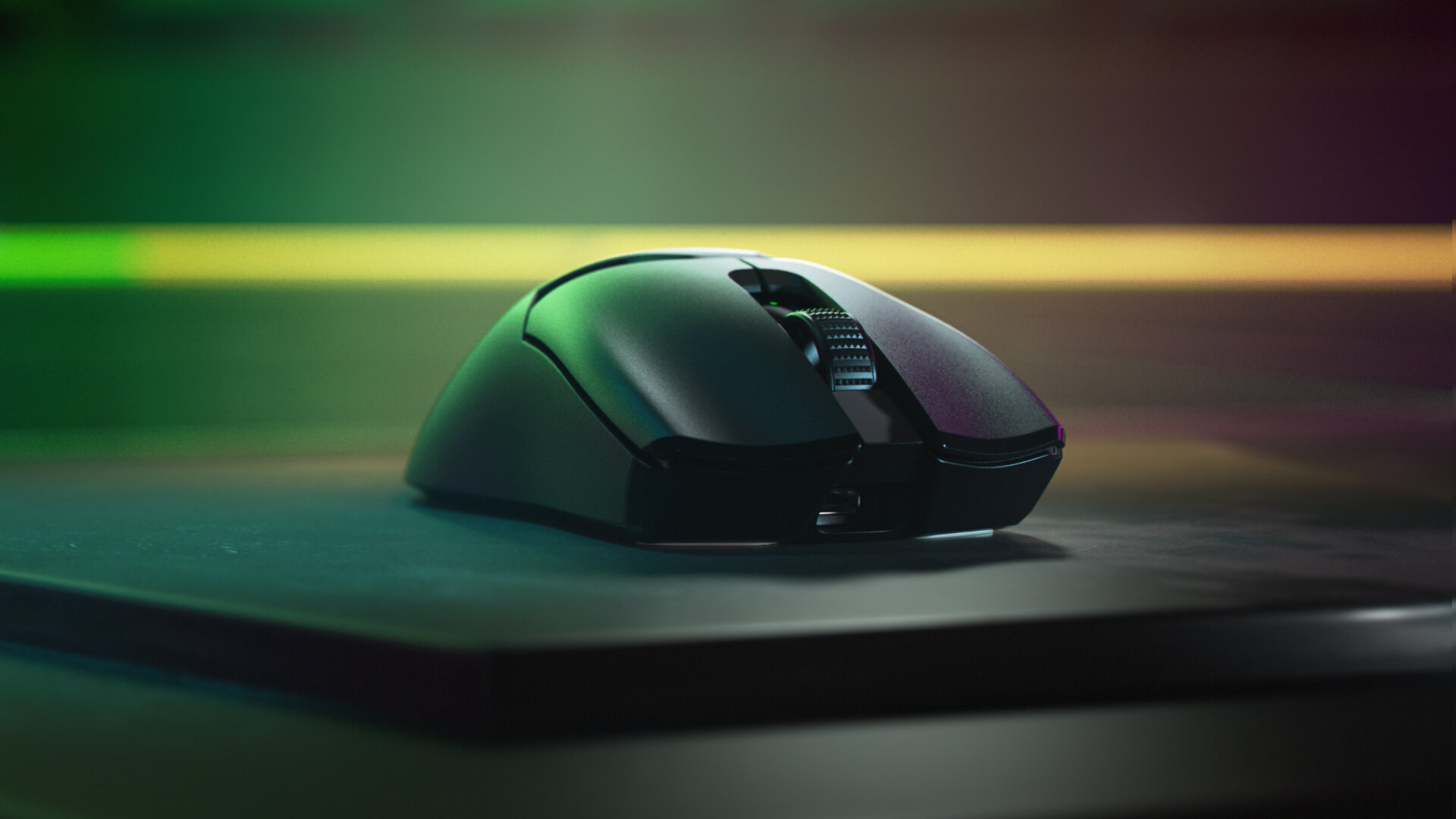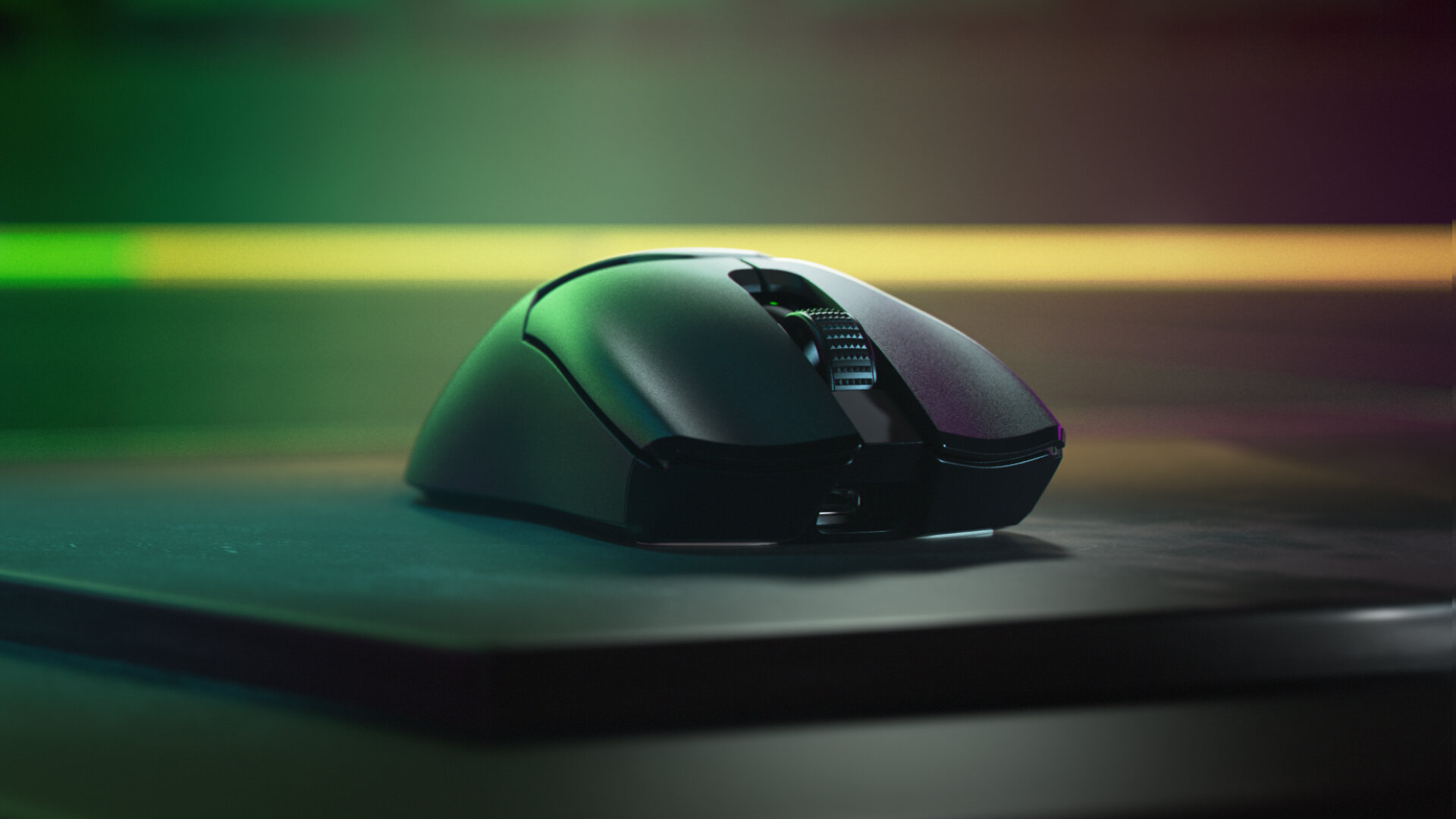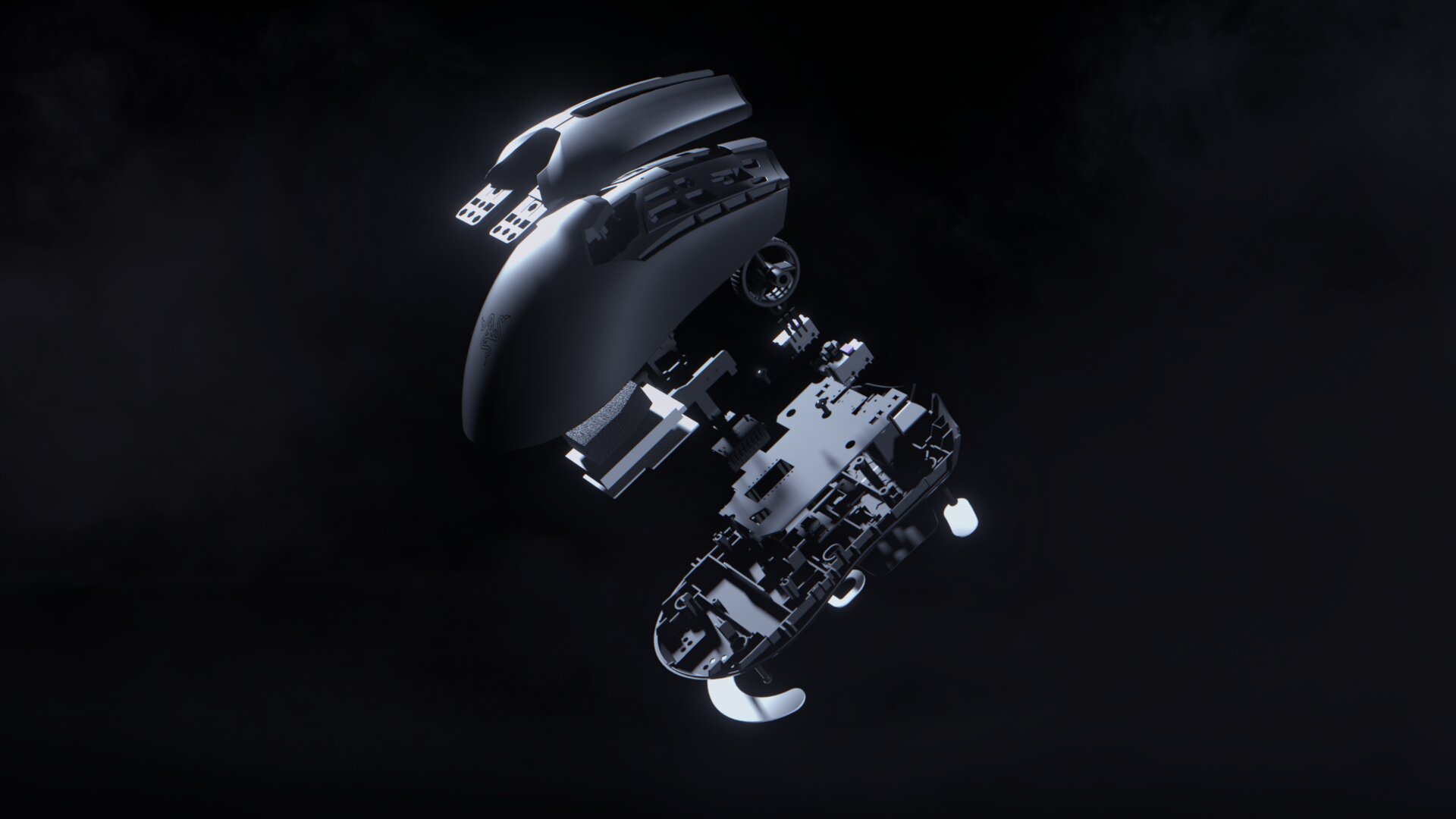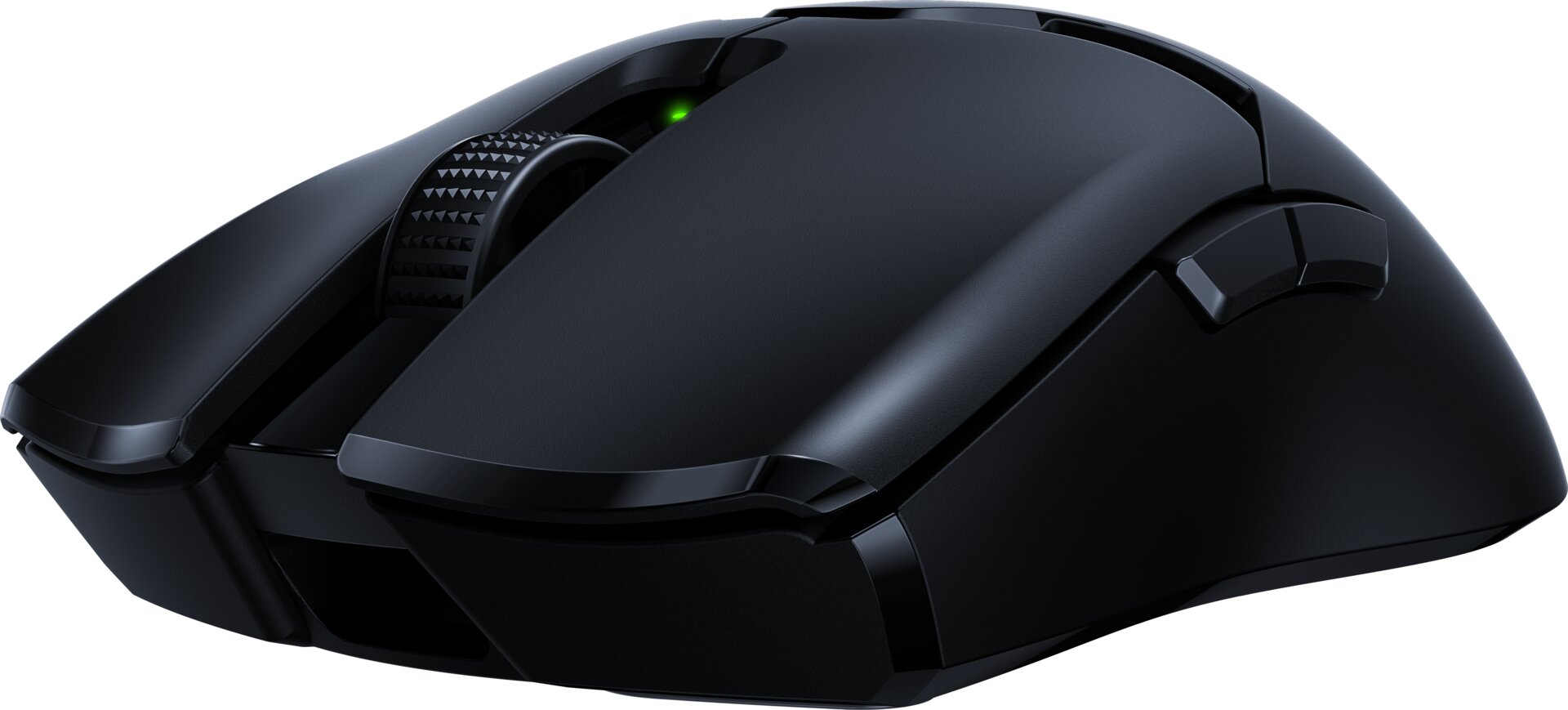It's that time of year again: something is happening in Logitech and Razer's competition for the best wireless shooter mouse. After Logitech presented the previous defending champion G Pro X Superlight (test) at the beginning of 2021 and had it compete against Razer's Viper Ultimate (test) from 2019, it's Razer's turn again in May 2022.
The striving for low and high numbers
The new Viper experiences the same optimizations that Logitech made with the G Pro Wireless (test). To reduce the weight even further, Razer does without right-hand thumb buttons for left-handers, RGB lighting and rubberized flanks. This puts the Viper V2 Pro at around 58 grams; 4 grams less than the G Pro Superlight and 12 grams less than the Viper Ultimate. This means that the new input device is undoubtedly one of the lightest gaming mice ever and the other specifications are also superlative.
Razer has replaced the PMW-3399 aka Focus+ working in the Viper Ultimate with a PAW-3950 aka Focus Pro, which was once again developed in cooperation with PixArt. The fact that the maximum measurable sensor resolution increases from 20,000 to 30,000 cpi is only of use to Razer's marketing department. There are also improvements in the other key figures. On the one hand, the maximum measurable speed increases to an unprecedented 19 m/s and the maximum measurable acceleration is now 686 m/s². All in all, Razer promises a precision of 99.8 percent – it used to be 99.6 percent. Motion Sync and Co. are also on board again. Meanwhile, the possibility of using the mouse on glass surfaces is new. The PMW-3399 and other gaming mouse sensors don't do well or at all on glass.
-
 Razer Viper V2 Pro (Image: Razer)
Razer Viper V2 Pro (Image: Razer)
Image 1 of 12
< figure class="thumbs thumbs--12" role="group">
 Razer Viper V2 Pro
Razer Viper V2 Pro  Razer Viper V2 Pro
Razer Viper V2 Pro  Razer Viper V2 Pro
Razer Viper V2 Pro  Razer Viper V2 Pro
Razer Viper V2 Pro  Razer Viper V2 Pro
Razer Viper V2 Pro  Razer Viper V2 Pro
Razer Viper V2 Pro  Razer Viper V2 Pro
Razer Viper V2 Pro  Razer Viper V2 Pro
Razer Viper V2 Pro The primary buttons use Razer's third-generation opto-mechanical switches for a more tactile click feel. According to Razer, there is no longer a haptic difference to mechanical microswitches, but unwanted double clicks are still excluded. The additional keys on the left side of the Viper V2 Pro stand out a little more, the same applies to the mouse wheel.
One last change with regard to the buttons can be found on the underside: Again, for reasons of weight reduction, one switch each for switching on and off and for sequentially changing the sensor resolution has been combined into a combined button. A look at the underside also makes it clear that Razer uses other sliding feet: Although pure PTFE is still used, rounded and more gently ground elements are now used instead of square feet with comparatively steep edges.
Less is more?
And there is also a long overdue innovation with the flexibly wrapped charging cable: instead of the micro-USB connection on the mouse side, Razer is finally using USB-C. That cable is also the only way to charge the 300 mAh battery of the Viper V2 Pro: charging contacts for Razer's docking station are missing – oh wonder – for reasons of weight reduction. Regarding the battery life, Razer meanwhile mentions 80 hours of constant movement at 1,000 Hertz. Compared to the Viper Ultimate, this is a decent step with a smaller battery, which was ultimately made possible by the more energy-efficient sensor and the lack of RGB LEDs.
But the low mass has another victim: Razer has reduced the internal memory of the Viper V2 Pro to just one profile instead of five. When asked by ComputerBase, the manufacturer confirmed that the weight would decrease as a result. No, this is not a joke.
The Gramm high-end e-sports shooter mouse costs 2.75 euros
All in all, by omitting features that are not necessary for mere gaming, Razer has created a high-end mouse that is aimed almost more at actual e-sports professionals than at ordinary gamers. And thus adopted the concept of the G Pro Superlight directly. It is therefore not surprising that the new low for the masses is accompanied by a new high for the recommended retail price: the Viper V2 Pro is said to cost 160 euros. This exceeds the RRP of the Viper Ultimate and the G Pro Superlight by 10 euros, but of course the difference becomes larger when compared to current market prices. After all, four grip tapes for the primary keys and flanks are included.
Razer Viper Ultimate Logitech G Pro WirelessLogitech G Pro X Superlight ✔Razer Viper Ultimate ✔Razer Viper V2 Pro ✔ Razer Viper V2 Pro Logitech G Pro WirelessLogitech G Pro X Superlight ✔Razer Viper Ultimate ✔Razer Viper V2 Pro ✔ Logitech G Pro X Superlight Logitech G Pro WirelessLogitech G Pro X Superlight ✔Razer Viper Ultimate ✔Razer Viper V2 Pro ✔ Ergonomics: Balanced (Ambidextrous) Balanced (Right-handed) Sensor: PixArt PMW-3399
Optical
Lift-Off-Distance: 1.0-3 .0mm PixArt PAW-3950
Optical
Lift-Off Distance: 1.0-3.0mm Logitech Hero 25K
Optical
Lift-Off Distance: 1.0mm Resolution: 100-20,000 CPI
5 levels 100-30,000 CPI
5 levels 100-25,600 CPI
5 levels Velocity: 16.5 m/s 19.0 m/s 10.2 m/s Acceleration: 490 m/s² 686 m/s² 392 m/s² USB polling rate: 1,000 Hz Primary switch: Razer Optical, 70 million Clicks Razer Optical, 90 million Clicks Omron D2FC-F-7N, 20 million Number of clicks: 8
Top: 3 Bottom: 1
Left side: 2 Right side: 2 6
Top: 3 Bottom: 1
Left side: 2 5
Top: 3
Left side : 2 special keys: mouse wheel
cpi switch mouse wheel Software: 5 profiles
fully programmable, secondary assignment
macro recording
Internal memory: 5 profiles 5 profiles
fully programmable, secondary assignment
macro recording
Internal memory: 1 profile 5 profiles
fully programmable, secondary occupation
Macro capture
Internal memory: 5 profiles Lighting: Color: RGB, 1 addressable zone
Modes: Breathing, Waves, Color loop
Reactive, Game integration
Profile indicator – Housing: 127 × 67 × 38 mm
Hard plastic, coating
Glossy elements, rubber elements
Sliding feet: PTFE (pure) 127 × 67 × 39 mm
Hard plastic, coating
Glossy elements
Sliding feet: PTFE (pure) 125 × 64 × 40 mm
Hard plastic
Sliding feet: PTFE (pure) Weight: 74 grams (without cable) Variant76 grams (without cable) 58 grams (without cable) 60 grams (without . cable) Connection: USB-A to micro-USB cable, 1.80 m, braided
Radio: 2.4 GHz
proprietary battery, 70 h runtime
Charging: cable, charging station USB A to USB-C cable, 1.80 m, braided
Radio: 2.4 GHz
proprietary battery, 80 h runtime
Charging: cable USB-A to micro-USB cable, 1 .80 m
Radio: 2.4 GHz
proprietary battery, 70 hours runtime
Charging: cable, induction (proprietary) Price: from €82/from €149 €160 from €99/from €108